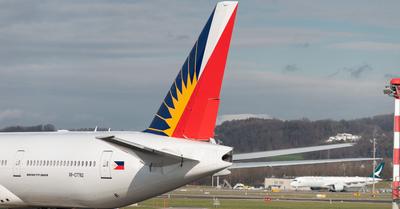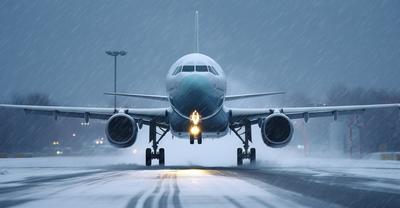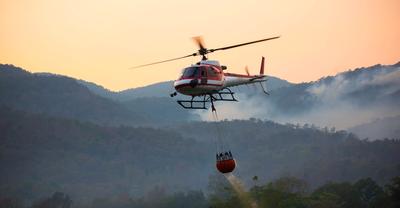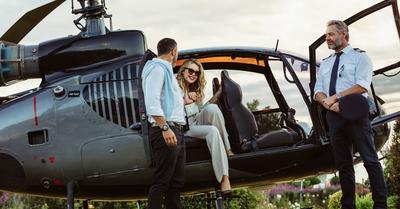This article may contain affiliate links where we earn a commission from qualifying purchases.
Becoming a pilot could be one of the best decisions that you ever make, but it’s not something you can do overnight. So how are pilots trained?
To become a commercial airline pilot, candidates have to go through ground school, pass written and flying exams, earn various ratings (including multi-engine planes and instrument ratings), have a minimum of 250 hours of actual flight time, and have an in-depth understanding of flight theory.
Choosing to become a pilot can be an exciting decision. Whether you want to have a prestigious career as a commercial pilot, defend your country as a fighter pilot, or just be able to relax and fly your own airplane on the weekends, you’ll need training to become a pilot. In this article, we’ll take a look at how these various types of pilots are trained so you have an idea of what you’ll need to do to take the next step in your dream to become a pilot.
Our biggest priority here at SkyTough is to provide you (and all of our readers) with the best, most helpful, and most accurate content that we can. We want you to come to our site with the confidence that you’ll leave with the answers you’re looking for. To ensure this, we thoroughly research all aspects of our articles and vett everything for accuracy. So when you read about how pilots are trained, you’ll know exactly what to expect if you’re thinking about becoming one.
How Are Commercial Airline Pilots Trained?
If you want to make a career out of being a pilot, then chances are high that you’re considering becoming an airline pilot. Not only is being a pilot a prestigious and well respected career, you’ll also receive great compensation and all sorts of other perks. Plus it’s just an exciting job all around! It’s no surprise that if you ask a classroom of kids what they want to be when they grow up, you’ll get a handful of them saying pilot.
After all, what other job out there do you get to fly a giant hunk of metal through the sky, tens of thousands of feet above ground, at hundreds of miles per hour? The answer is, well, none. Only as a pilot. So let’s take a look at how commercial pilots are trained and what you can expect if you want to become one yourself.
Something that many people don’t know, even prospective pilots, is that the vast majority of commercial airline pilots already have experience as either regional airline pilots or military pilots. This is why airline pilots are actually some of the best pilots in the world, and also one of the reasons that the salaries are so good and there are so many great perks of being an airline pilot!
That said, let’s start from the beginning. Since I’ll go into more detail in the next section about becoming a military pilot, for this part of the article I’ll assume you want to become a commercial pilot as a civilian, not after serving your time as a military pilot.
The first thing you’ll need to do before becoming a commercial pilot is to obtain your private pilot’s license. This requires you to pass a medical exam, take ground school (flight training classes), pass a written exam, have a minimum of 40 hours of flight time (usually closer to 50 to 75 hours), and pass a check ride with a Federal Aviation Administration (FAA) examiner.
After earning your private pilot’s license and learning the basics of flying single-engine aircraft, it’s time to step it up a notch. Next, you’ll spend time earning an instrument rating. This will enable you to fly using Instrument Flight Rules (IFR) so that you can fly even in poor visibility conditions since you’ll be able to rely on your instruments alone. You’ll also need to earn a multi-engine rating so that you can fly larger types of planes, such as commercial airplanes.
Lastly, you need to obtain a minimum of 250 hours of flight time before you will finally earn your commercial private license. After that, you can then become certified on various airplanes depending on which airline(s) you decide to work for. You’ll likely need to also complete training annually to stay up to date on the various planes and systems. Again, that would be at your particular airline’s discretion and direction.
How Long Does It Take To Become A Commercial Pilot?
As you can imagine from everything you just read about, becoming a commercial pilot is not something that will happen overnight. It requires you to commit some serious time into the process before you even have the chance of landing your dream job as an airline pilot. One thing I didn’t even mention above is getting a four-year college degree.
I left that out since it’s not exactly necessary to get a degree to become a pilot, but the truth is that many airlines do require one on their own. So if you include getting a degree as part of your journey to becoming a pilot, it will take even longer. If you do choose to get a degree first, try to get one in a field related to aviation, mathematics, or science as those are typically the ones that airlines will look for most.
Outside of pursuing a degree, becoming a pilot will typically take around 2 years or so. This includes the training and requirements necessary to earn your private pilot license (typically about 3 months). Then it also includes everything else needed to go from a private license to a commercial pilot license, including earning your ratings, becoming proficient with aircraft, and completing the necessary 250+ hours of flight time.
How Are Fighter Pilots Trained?
Becoming a fighter pilot is the dream of many people across the country — and even the world. The ability to fly the world’s most advanced aircraft, travel at speeds and heights impossible in any other career, and defend one’s country makes becoming a fighter pilot one of the most respected careers in the world. But it’s not easy, nor is it a short process.
Before you can even begin pilot training, you’ll need to have a four-year degree from an accredited school. For the best chance of being selected for pilot training, you’ll want to get a degree in a field related to flight. Whether that’s aerospace engineering or any sort of math or engineering field that looks into fluids, physics, and other similar fields, a STEM-related degree will increase your chances of becoming a fighter pilot.
Once you get selected for pilot training, the fun will really begin. I could go on for days (and multiple articles) about all the different aspects of becoming a fighter pilot, but I’ll keep it a bit short and hit the high points in this article. These are the main aspects of fighter pilot training:
- Initial Flight Screening is done in Colorado to check a potential pilot’s aptitude for flight and to introduce candidates to what’s required and expected of them during military aviation training.
- If selected for pilot training (such as Undergraduate Pilot Training at Columbus, AFB), students will begin flying the T-6 Texan II propeller plane to learn instruments, contact, low-level, and formation flying in a relatively easy to fly aircraft.
- After mastering the T-6, students move on to the T-38 Talon to begin learning how to fly a fighter jet. From there, you can continue training and once complete, you have the potential to be a fighter or bomber pilot.
Keep in mind that only some students will be selected to this program based on current military needs. So it’s not exactly a guarantee that you’ll become a fighter pilot even if you join the military to become a pilot! Including the 4-year degree program, you can also expect it to take anywhere from 6-7 years to complete, so it’s a bit of a commitment just to have the chance at becoming a fighter pilot.
How Long Of A Commitment Do Fighter Pilots Have To Make To The Military?
As you can probably guess just from the fact that becoming a fighter pilot requires being a member of the military, you’ll need to make a service commitment to remain as a fighter pilot. As a pilot for the Air Force, you’ll be required to commit to 10 years of service, beginning on the day you finish pilot training.
So all of the training time that it takes to become a fighter pilot that we went over above is not included in your 10-year service commitment. This long of a commitment might be off-putting to some, but when you think about the time and money that the government invests in training fighter pilots, it starts to make a bit more sense.
It is estimated that the cost to train a single fighter pilot ranges from $5.6 million for a F-16 pilot up to $10.9 million for an F-22 pilot. Yes, you read that right. It costs the government up to nearly $11 million to train a single fighter pilot. That monetary cost, plus the time cost, and the cost of entrusting aircraft worth hundreds of millions of dollars, a 10-year commitment suddenly doesn’t seem so out of line!
The military and the government as a whole demands a return on their investment. For you, you get world class fighter pilot training and the opportunity to fly the most advanced aircraft in the world. In return, the military expects you to serve for 10 years and to be the best fighter pilot you can be while serving.
How Do You Become A Private Pilot To Fly Your Own Plane?
Since becoming a private pilot is a prerequisite of becoming a commercial airline pilot, some of this was briefly touched on above. But I’ll go into a little more detail in this section for the sake of completeness, just in case you’re like me and you’ve skipped to this section since it’s all you’re really interested in! Becoming a private pilot is the easiest of all three types of pilots listed here, and also takes by far the shortest amount of time.
To start, you’ll need to obtain a medical certificate (minimum of third class) indicating that you are medically capable of flying an aircraft. Next, you’ll need to attend ground school to learn the basics of aircraft and flying. Ground school typically takes around 4 weeks or so, and can sometimes even be done virtually rather than in person. After finishing the classes, you’ll need to complete the FAA written exam before moving onto actual flight.
After passing your written exam, you’ll need to complete at least 40 hours of actual flying. This flying must include daytime and nighttime flights, cross-country flights, solo flights, and flying with an instructor. Although the 40 hours required is a minimum, students often take 50 - 75 hours or more of flight training before they feel proficient and confident enough.
The final step is passing your check ride with an FAA examiner. During the flight, the examiner will monitor how well you plan the flight, handle maneuvers, communicate with ATC, and respond to all directions from them. Once you pass the check ride, you will officially earn your private pilot’s license and be able to fly on your own. Expect the entire process to take around 3 to 4 months on average.














